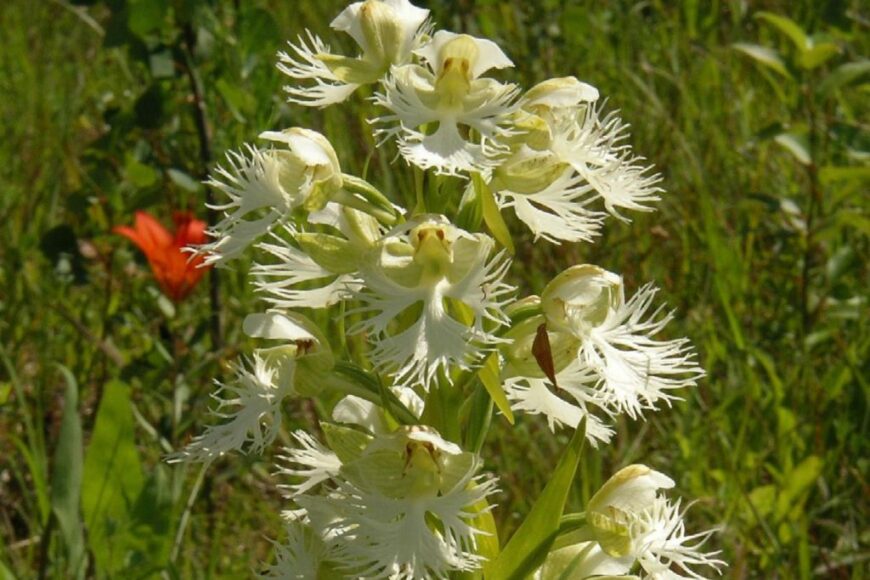The Carillon, written by Jura McIlraith Friday, July 7, 2023
https://www.winnipegfreepress.com/the-carillon/local/2023/07/07/preserving-a-precarious-orchid
The hot July sun beats down on delicate white blooms along the Agassiz Interpretive Trail. If you get close enough, you can smell vanilla coming from their petals.
The only place in Canada the endangered western prairie fringed orchid can be found is in this little corner of Manitoba. Roughly 50 per cent of the world’s population of the flower grows on a 48 square kilometre piece of land just outside Vita in the RM of Stuartburn.
“We thought there was no better way to spend Canada Day than to see a flower that you can see nowhere else in Canada,” said Norm Gregoire, community liaison for species at risk with the RM of Stuartburn.
Gregoire held two nature walks along the trail last Saturday to teach about the elusive flower, drawing 59 people from nearby communities and from as far as Winnipeg.
Multiple orchids could be seen in the tall-grass prairie preserve land and along the ditches along the highway. Gregoire said the orchid numbers can vary drastically, going from only 1,000 blooming plants one year to 22,000 the next.
He said the goal of the preserve is not to necessarily expand the habitat for the flower but sustain the number for future generations and to keep biological balance.
“What’s important is to save the remaining ones that we do have because every one that’s lost is essentially gone forever,” Gregoire said.
The western prairie fringed orchid can grow up to three feet tall and have anywhere from five to twenty-five blossoms. The flowers bloom from the bottom up.
Another feature that sets this orchid apart from others is its need for a specific pollinator.
The flower releases its vanilla-like scent at night to attract the nocturnal pollinators, Sphinx moths. Although the moths are able to pollinate other species of flower, their body size and shape fit perfectly into the fringed orchid and allow them to drink the nectar.
In Manitoba, Sphinx moths are reaching their northern range meaning that their peak flying time does not line up with the fringed orchid’s peak bloom period, making their survival even more precarious.
Gregoire believes that everyone and everything is connected and everything has its place in nature whether it’s a tiny insect, a large predator or humans. The disappearance of one species may not be noticed right away but could cause a ripple effect of other losses.
“We all have our roles and when you do lose that one link in the fence or one thread in the spider web, it all can collapse,” he said.
Manitoba is home to roughly 59 endangered or at-risk species, with 28 of them calling the tall-grass prairie home. This includes the northern leopard frog, barn swallow, monarch and Poweshiek skipperling butterflies and snapping turtles.
Marilyn Mackie lives in the area and is interested in the endangered species and wildlife that live near her. She wants others to learn the importance of living sustainably and keep the land as close to nature as possible.
Mackie said she had never seen a western prairie fringed orchid up close before.
“I’m just so grateful. I felt a little emotional because we’re so close to it and I didn’t really know… that this was all here,” Mackie said. “That really amazed me and awed me.”
Gregoire added that local landowners are a huge part of the conservation efforts. Tall-grass prairie needs disturbance that mimics bison grazing and natural forest fires that no longer happen. Without it, woody encroachment occurs and trees take over what was once grasslands.
Gregoire warned that these orchids should not be transplanted in an effort to help them grow, as they have a symbiotic relationship with fungi in the ground and need calcium rich soil. Removing them from where they naturally grow means they will only live for a fraction of their lifespan.
Instead, Gregoire encourages locals to be stewards of the land and look into the Stewardship Credit Pilot Program within Stuartburn to protect tall-grass prairies.
“I want the next generation to have those opportunities to be able to walk through true tall-grass prairie and to be able to smell the purple prairie clover… and get down on their hands and knees and smell the western prairie fringed orchid,” Gregoire said. “I think that’s really important.”
Gregoire is holding more free nature walks before the orchids stop blooming for the season. Those interested can contact him at info@sharedlegacymb.ca.

